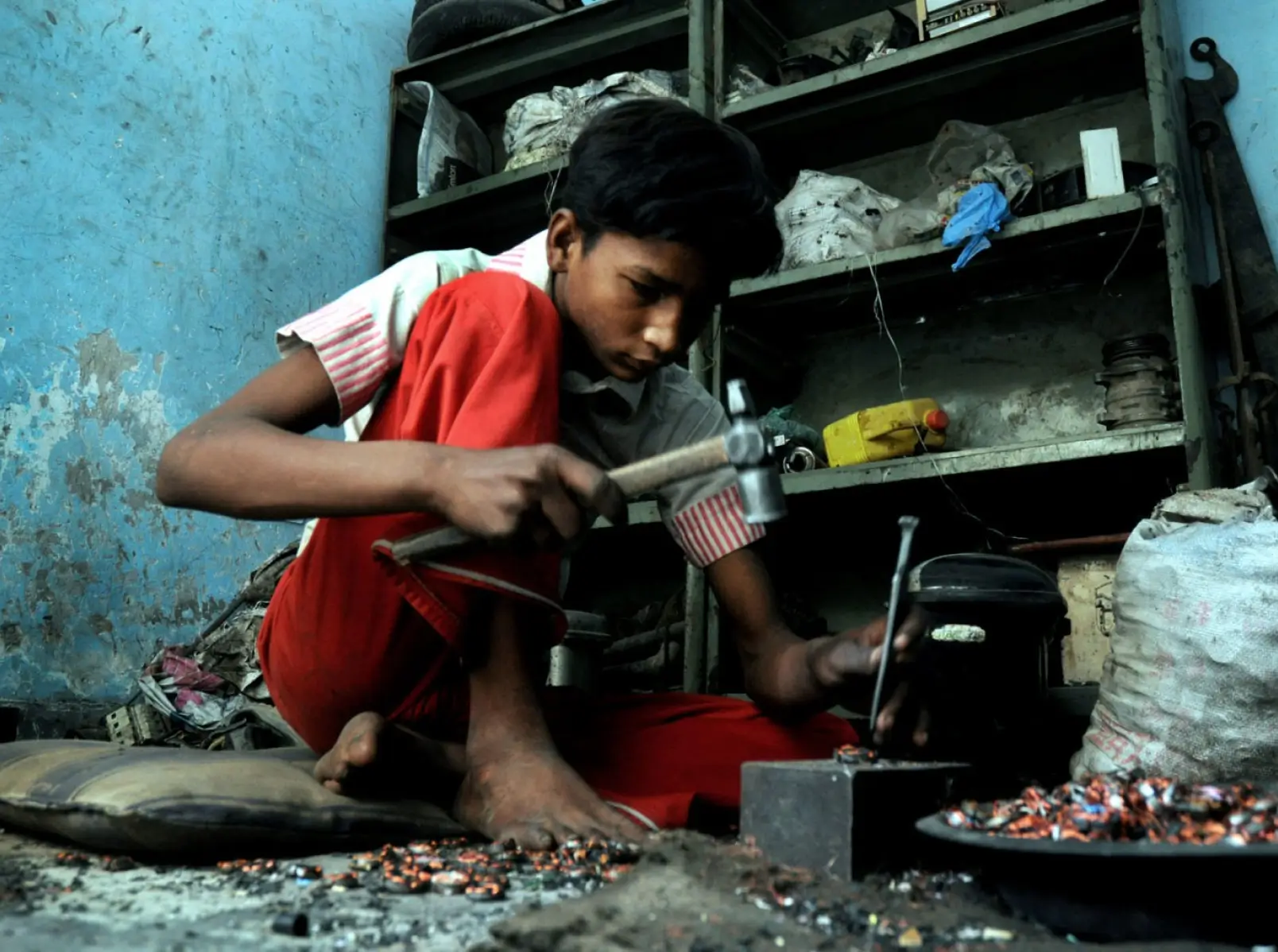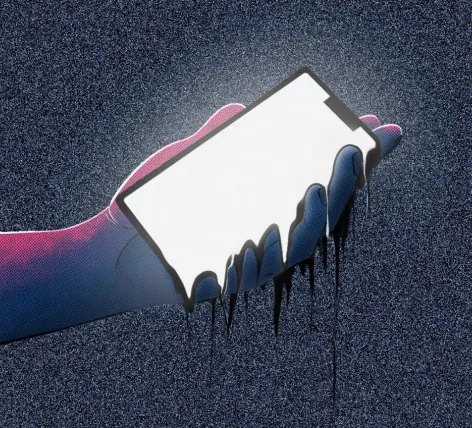Nearly a quarter of India’s three million tonnes of e-waste generated every year is dumped in Seelampur. If you live in north India, chances are high that the smartphone you bought last year and trashed because something better came along, went to die here.
I’m walking through a frenzied beehive of activity on a dry March afternoon. Around me is a blur of motion as people rush past, barely noticing me. I am clearly the outsider. Everyone’s carrying something on their backs. In front of me, a narrow, stinking nullah runs through piles of discarded metal.
This isn’t any metal. These are the guts of discarded mobile phones and computers. They lie on the ground, strewn carelessly along at least a dozen lanes that connect the main road on the left to maze of lanes that surround me. Along the dirty rivulet, trucks, both small and large, are parked with their backs wide open. Men and teenage boys dart about, hauling cartons full of electronic junk from the trucks and taking them to houses that dot the lanes.
“Please be careful,” Vinod Kumar, a volunteer with Toxics Link, a NGO specialising in research and policy advocacy on electronic waste or e-waste, has cautioned me. “These people might get offended if they realise you’re taking pictures or making notes.”
I am in Seelampur, a semi-urban pocket located approximately 10 kilometres northeast of New Delhi. It’s a relatively young town, created in 1993 to relocate people living in north and central Delhi who were displaced after their homes were knocked down in the Emergency in the seventies.
Today, its claim to fame is being India’s digital underbelly.
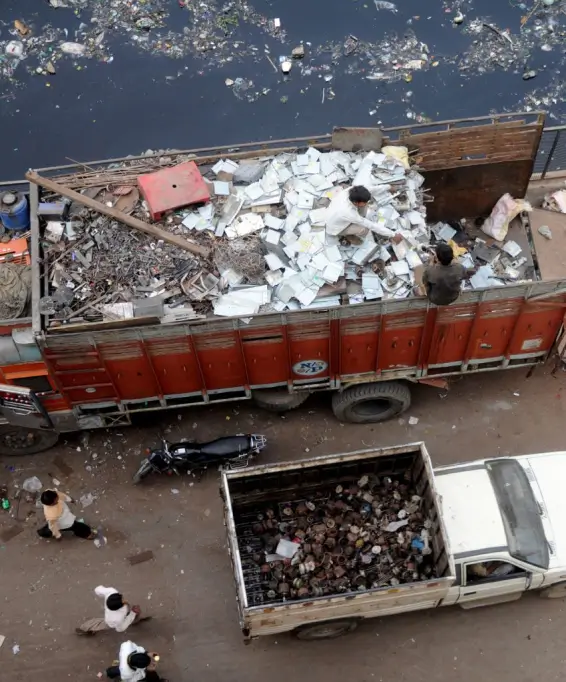
Nearly a quarter of India’s three million tonnes of e-waste generated every year is dumped in Seelampur. If you live in north India, chances are high that the smartphone you bought last year and trashed because something better came along, went to die here.
India’s technology revolution and its hunger for cheap smartphones has had a nasty fall out: we are now the fifth largest generator of e-waste in the world. Last month, the country rejected a proposal from Apple seeking to sell refurbished iPhones citing fears of an American company treating India as a “dumping ground” for secondhand phones. Apple CEO Tim Cook, who met Prime Minister Narendra Modi on his multi-day India tour last week, presumably made one more push to let the government sell refurbished iPhones. Cook could have helped set the tone by talking about Liam, an iPhone recycling robot that Apple showed off just two months back.
Harvesting metal, a milligram a time
Ashfaq Ahmed, 40, is no Liam. He looked up at me with eyes that looked tired and hurt. He was breaking down an old IBM personal computer, trying to dismantle the motherboard before it could be put through an acid wash.
“Are you from an NGO?” he asked me.
No, I said. I was there to write about e-waste and its impact. Ahmed looked unperturbed.
“What’s there to write about?” he said. “We’ve been recycling waste over four generations. E-waste is just the new waste.” As I stood there talking to Ahmed, I realised that workers nearby had started getting suspicious of my conversation with him. And before one of them could come up and ask any questions, I pretended to take a call on my phone and walked away quickly. “It can be dangerous if they find out that you’re a journalist writing about e-waste issues,” another worker told me later.
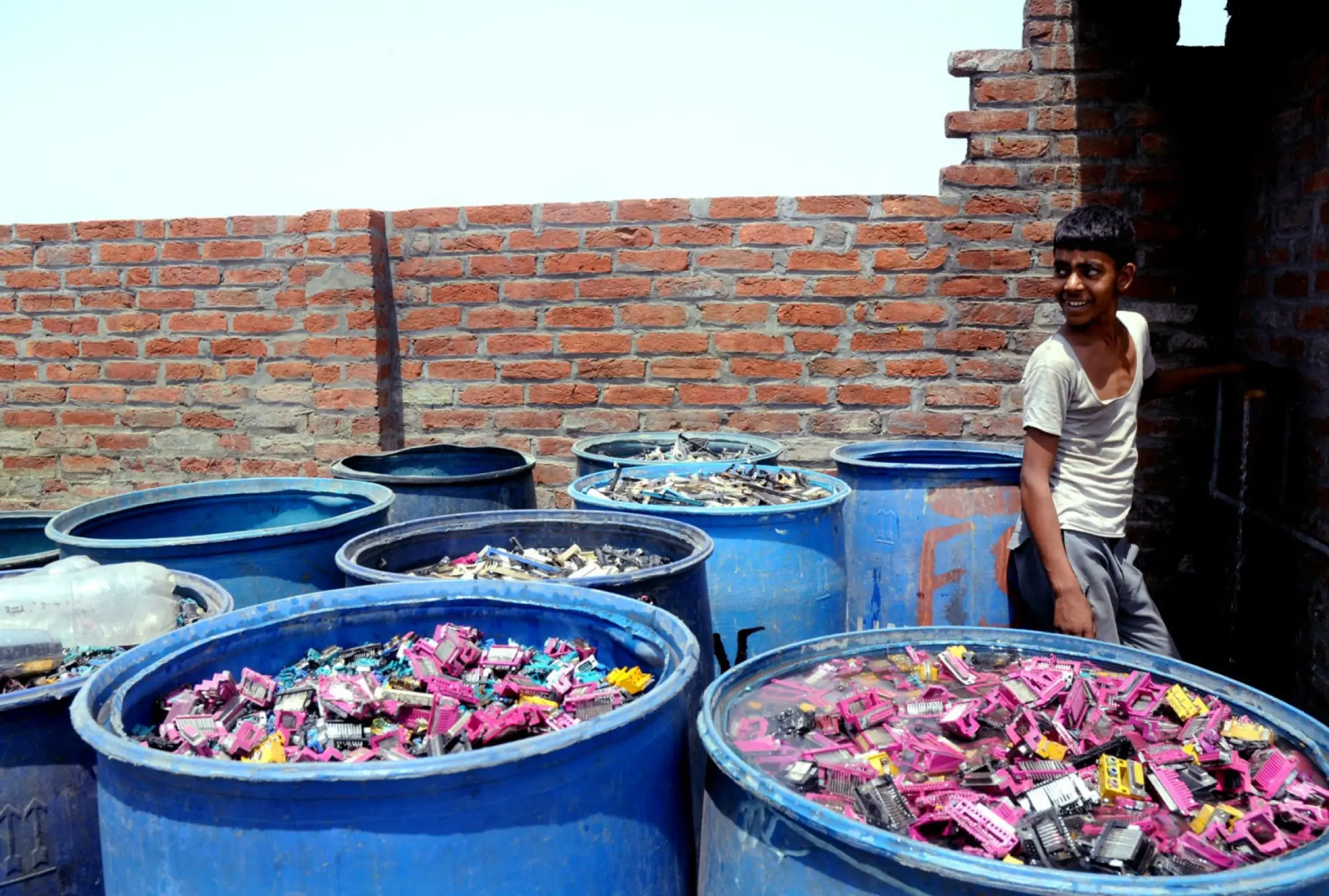
The media and NGOs, Seelampur’s e-waste workers think, bring unwanted attention to India’s e-waste problem. “Some NGO people came last time with foreigners and there were police raids weeks after that,” according to another worker. To be sure, there is other economic activity like forging, jeans stitching units, incense stick rolling and other small industries, but none of those bear the brunt of the police as much as the e-waste businesses.
Seelampur is not the only place in the country where generations of workers like Ahmed have been taking electronics apart. Moradabad in Uttar Pradesh; Loni, Mundka and Mandoli on the outskirts of Delhi; Kolkata and its suburbs in West Bengal; and Perungudi, Ambattur and Guindy in Chennai district are among hundreds of poorly regulated hubs that deal with nearly three million tonnes of e-waste annually.
The story in all these hubs is the same. Hundreds of thousands of men, teenaged boys and even women are employed in India’s unorganised e-waste recycling sector, hunting for precious metals such as lead, copper, aluminium, brass, silver and even gold from piles of motherboards, circuit boards, computer server cards, and what have you.
Motherboards are dipped in sulphuric acid for extracting silver and gold. Circuit boards are cooked in high flames to extract copper. Other discarded computer and phone components are treated to get the tiniest extracts of precious metals, including hazardous ones like lead, which finds hungry buyers in the informal — and formal — battery industry. Other precious metals that can be extracted from e-waste include platinum, gallium, palladium, tantalum, tellurium, germanium and selenium — finding their way into myriad products like jewellery and batteries.
It all starts when you exchange your old phone with a new smartphone. After giving you the discount in lieu for the phone, the shopkeeper trades it with a recycler in Seelampur or elsewhere. Shastri Park in Delhi for instance, is the hub for dismantling e-waste, mostly phones, and it’s not too far from Seelampur.
If it’s a working phone, it gets buffed and sold as a second-hand product. “We still get old Nokia phones in working condition. Workers in our own colony buy it for Rs 500 or more,” says Ahmed. He and his coworkers are not always the best to judge whether an electronic product has any life left in it. Often, there are smaller scrap traders who frequent Seelampur and other such clusters looking for products that can be refurbished or resold.
Dismantle, segregate, extract: For Rs 200 a day
Much before the recyclers get to extracting precious metals, dismantling happens in a hub like Seelampur where chips from phones, and other components are taken apart. Some of these components are also used by repair shops to fix broken parts of everything from television to a mobile phone.
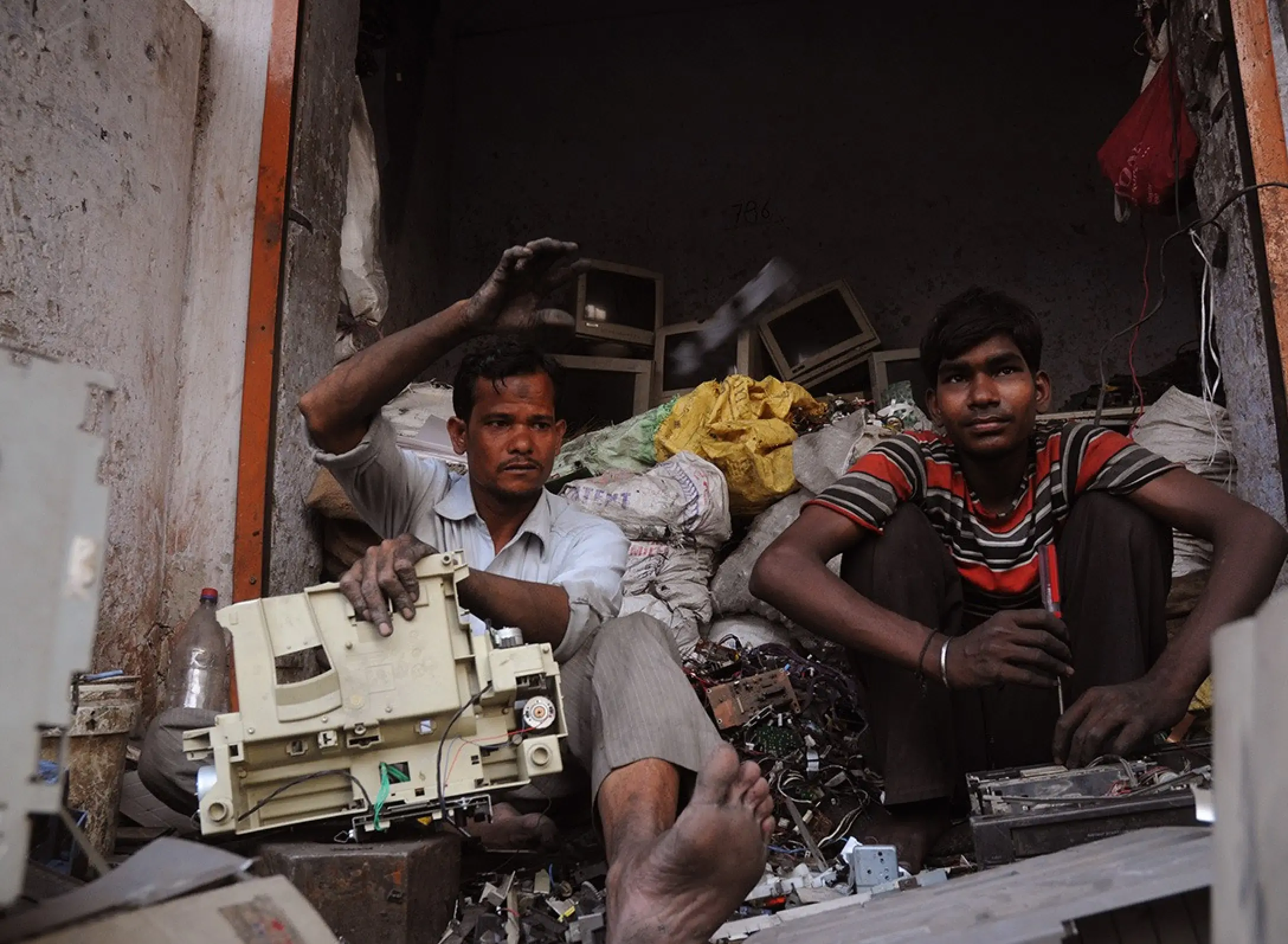
Plastics, metallic parts and circuit boards are segregated first. Plastic goes to Mundka or Tikri Kalan in Delhi, from there it goes to Bawana, Nangloi among other clusters where plastic can be processed. Circuit boards with precious metals like copper, lead and gold go to Moradabad, which specialises in gold extraction. Other parts go to Mandoli and Loni where lead and copper are extracted after acid wash. In Seelampur, hot blue torches are used to melt the boards, too.
Who buys the extracted metals? There are formal copper smelting plants that mostly buy the extracts, purify and then use further. Lead has many takers among the battery industry, which too is informal for the large part. In Mandoli, for instance, there are battery manufacturers who engage in quick cash transactions.
There are around 170 authorised recyclers in India currently. Attero Recycling for instance, have network to collect e-waste from across the country and it’s all processed at the company’s Roorkee plant. Of these, only four or five are real recyclers, the rest are dismantlers.
Priti Mahesh, a senior programme coordinator at Toxics Link, who has spent over a decade researching e-waste, says the informal recycling network is “really big” but it is difficult to put a number to the number of people involved in it or the number of dismantlers or recyclers. She reckons at least 90% of the e-waste in the country is dismantled and recycled in unorganised hubs like Seelampur but the efficiency of extracting metals is abysmally poor — as low as 20%-30% — because the extractors do not have sophisticated equipments and the labour does not have any expertise in dealing with the complex requirements.
Most workers in Seelampur earn less than Rs 200 a day. Their income is linked to how much they can dismantle and extract every day. It also depends on what they extract. As Naved, another worker in Seelampur told me, metals like copper can fetch Rs 400 or more a kilo. Gold and silver can fetch much more but gold extraction is fraught with danger.
As Rohan Gupta, COO of Attero Recycling, a Noida-based e-waste management company, pointed out, these workers use cyanide while extracting gold in a process called gold cyanidation — normally used by some of the world’s biggest miners as a metallurgical technique to extract gold from low-grade ore.
The economics justifies the means for the poor in Seelampur. Extracting Gold from useless smartphones is indeed lucrative. For instance, 41 smartphones contain a gram of gold — worth about Rs3,000. For every one million smartphones recycled, 16,000 kg, 350 kg of silver, 34 kg of gold, and 14 kg of palladium can be recovered, according to Attero.
Dying slowly every day
Metals extraction and toxic fumes have played havoc with the health of workers in Seelampur. As I walk around the narrow stream, the water starts getting darker as residual waste from acid-washing computer chips is dumped into it.
“It’s like a curse that we must live with — the money is better than what the government job schemes offer. But the price we are paying terms of health hazards is huge,” says Abid, who uses only his first name and cautions me about not looking conspicuous or talking to too many people.
According to a study by Assocham, a Delhi based industry body, last year, 76% of India’s e-waste workers are prone to cancer and suffer from weakened immune systems. For each metal they extract, workers such as Abid run the risk of damaging their health in several ways as the Research Journal of Chemical and Environmental Sciences points out. For instance, lead can damage central nervous system, kidney, and even affect brain development of children exposed to it.
Weighing the burden of e-Waste
| HAZARDOUS SUBSTANCE | NON-HAZARDOUS SUBSTANCE |
|---|---|
| Lead Chromium Mercury Beryllium Cadmium Sulphur Arsenic PVC Retardants | Aluminium Lithium Copper Gold Iron Nickel Tin |
e-WASTE
EFFECTS
e-WASTE
EFFECTS
e-WASTE
EFFECTS
e-WASTE
EFFECTS
e-WASTE
EFFECTS
e-WASTE
EFFECTS
e-WASTE
EFFECTS
e-WASTE
EFFECTS
e-WASTE
EFFECTS
Much of the demand for recycling can be traced to the avarice of Indians — and, indeed, people all over the world — for the latest electronic gadget. The race to flood the India market with mobile phones has never been bigger. According to a study from 91Mobiles.com, 90 brands launched 256 mobile phone models in India in the last three months alone. “Most of the technology products today, especially phones, are built to become obsolete faster,” says Mahesh of Toxics Link.
The phenomenon even has a name — “planned obsolescence”. In December last year, a lawsuit filed in a New York court accused Apple of engaging in planned obsolescence, and claimed $5 million in damages.
India’s burgeoning middle class is a happy consumer of such planned obsolescence — buying phones by the container loads.Phone makers sold 97 million phones in India in 2015, estimates Cyber Media Research, making it the world’s fastest growing market for such devices. One such buyer is Kumar Kaushal, a student, who lives in Patparganj, a middle class neighbourhood in East Delhi. Kaushal, 24, has changed his mobile phone nearly a dozen times in five years — more than two a year. He is unaware that his older phones may have gone to Seelampur to die.
If the environmental and human costs of e-waste processing are so high, why hasn’t more of such work moved to organised processors? (E-waste quantities are estimated to be growing at 25-26% year on year.) One, governments are quite oblivious to the scale of the problem. Local and state governments, which are responsible for pollution control certificates since 2011, often turn a blind eye to the situation. Some NGOs have been battling the problem but it is too little to make a big impact.
Two, for a country producing nearly three million tonnes of e-waste, there are only about 100 recyclers authorised by the government in India, according to Toxics Link. And, not all of them are equipped with end-end-end capabilities to recycle e-waste in an eco-friendly manner. Globally, companies such as Umicore in Belgium, have more sophisticated recycling infrastructure than most counterparts in India. Companies such as Attero in India are taking steps in that direction, too, but again it is a tiny effort.

The informal recycling sector in India needs a reboot, a massive overhaul. For its part, Attero has been trying to work with the e-waste recyclers in Seelampur doing small pilots asking informal recyclers to come and sell their e-waste to the company. But according to Gupta, until all the stakeholders, including technology manufacturers, actively participate, it cannot be scaled beyond a pilot. Attero also launched Gobol.in earlier this year, selling refurbished phones and other electronic devices online.
I’ve been walking around the cramped lanes of Seelampur for six hours and it is beginning the get dark. In the distance, bang in the middle of the metallic mess, is a small shack selling tea. The owner, Asgar, is 39 but looks about 50. As I sip a steaming cup of sickly-sweet tea, I see doors, half-open, in the street I am in. Young children are prying apart motherboards inside.
As I get up to leave, a beautiful nine-year-old girl walks in to fetch tea for her father and her uncle. She’s coughing constantly. I ask Asgar if it’s the weather.
“They cough all the time,” he says. “The air is so heavy here that it becomes difficult to breathe every time there’s even a slight change in the weather.” said Asgar. I ask him if he suffers from any respiratory problems. He doesn’t, thankfully, he says.
While researching for the Seelampur story, I thought we would chronicle a series of articles traveling across other e-waste recycling clusters of Moradabad and other places. But then I realised that while the frames will be different in terms of location and the setting, there wouldn’t be much to tell in terms of fresh narratives. I have dropped the idea.
It’s twilight as I make my way back along the blackened stream that cuts through Seelampur. The sky is dark but the water in the stream is darker. I stand at the junction that overlooked the Seelampur metro station on one side and the urban mess that is the e-waste capital of India, on the other. It was almost like they were two isolated and contradicting worlds — one, reflecting modern, urban progress and the other, the dark, digital underbelly of among the world’s hungriest technology consumers.
Dusk falls but the deafening chorus created by dozens of hammers breaking down old computers and phones around me shows no sign of stopping — a background score to a tragic movie.
Image Credits: Centre For Science and Environment/Sayantan Bera




